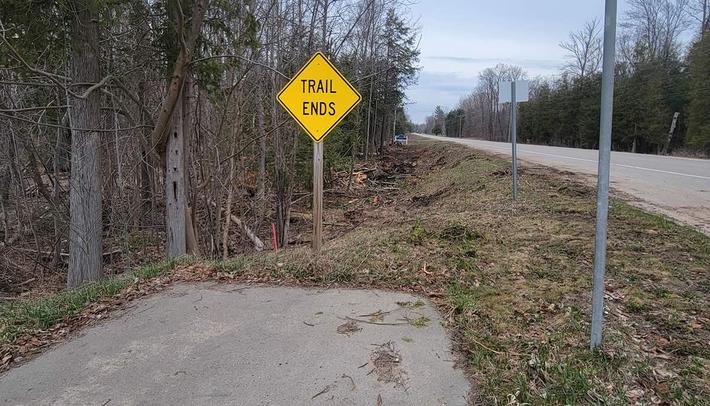Goodbye Animals
Aug. 23, 2006
Nearly a year ago, there was a lot of agreement on what to do with the Traverse City Clinch Park Zoo. The majority of residents believed the zoo was too old, too noisy, too small. Close it, they said, and put the animals in a new, expansive, educational wildlife park.But any hopes of a “new home” vaporized last winter as every interested party in the zoo fell away.
Looking back, the bottom line is that building a wildlife park was a very long shot. Citizens for a Wildlife Center, which promoted the idea, had passion, but no money, something that wasn’t underscored during the City Commission’s discussions. Then a fatal political decision to immediately find out-of-city homes for the animals alienated the group, which has now folded.
Actually, everyone has picked up their marbles and gone home, and the zoo animals are gradually leaving too. This fall, the bobcats, wolves, bears, and mountain lions are slated to move to the Wildlife Science Center in Minnesota, which received money from the Traverse City Commission ($58,000) and the Grand Traverse Zoological Society ($75,000) for new cages and moving fees. The otters, birds, elk and all but one partially blind and aging deer have already left.
SAD TIME
Visitors to the zoo, especially those from out of town, had mixed feelings about the animals leaving.
“I’m sad that it’s closing,” said James Girolamo of North Carolina, who was at the zoo with his five-year-old daughter. “I grew up here. We used to come here for field trips all the time. It was very depressing to see it was closing.”
Sue Suhy of Honor felt that closing the Clinch Park Zoo was the right thing to do, although she is disappointed that the wildlife center isn’t happening.
“I’m glad the animals will have better habitats-with the wolves pacing all the time. I felt sorry for them,” Suhy said.
Libby McKay said that the zoo was one of the reasons she moved to Traverse City in 2001. She felt that most of the animals, like the coyotes, had acclimated to their cages, but others—such as the bears and elk—definitely needed larger habitat.
In any case, most all the animals will soon be gone, and time is growing short to say good-bye.
A PERFECT STORM
Whether for good or bad, you could say a perfect storm closed the zoo.
First, there was Margaret Dodd, who said that the zoo was her biggest reason to run for mayor (she served 2001-2003). The zoo was hemmed in by a busy city of festivals and traffic. She also felt the cages were too small. Dodd said she can’t even think about taking the lead on building a wildlife park, because she’s physically unable to do so. Last spring, she took an antibiotic for a throat infection and it nearly destroyed her liver and almost took her life. She’s still trying to regain her health, a touch-and go proposition.
Second, a survey of residents in 2004 showed that 78 percent felt the animals had too little space. Interestingly, 63 percent said they’d support a one-mill bond proposal to finance a $7 million relocation.
Then came along Citizens for a Wildlife Center, a group headed up by Katharine Douglass. The group promoted the idea of a wildlife park that was educational for kids and provided expansive, woodsy cages for the animals.
The group had met with officials from the Conservation District, a local unit of state government that focuses on outdoor education, taking kids on 60 hikes each year. The two groups tossed around the idea of building a wildlife park off of Cass Road just beyond the railroad tracks south of Traverse City. The Conservation District leases six acres on a beautiful parcel of several hundred acres, owned mostly by Grand Traverse County. The Conservation District was already planning on building an educational center on a six-acre spot that it leases.
“We researched this (the wildlife park) further and discussed it further, but it never really went very far with the wildlife park notion. But we did decide to incorporate the zoo’s educational resources at the nature center,” said Lew Coulter, executive director.
TURTLES & SNAKES
The Conservation District also plans to take in the zoo’s turtles, snakes, and reptiles. As testament to what would be involved for building an entire wildlife park, Coulter said the 7,000 square-foot nature education center alone will cost $1.5 million to build, with ground-breaking planned for this spring—so far the Conservation District has raised $600,000.
Trying to tame this perfect storm was the Grand Traverse Zoological Society, which wanted to keep the zoo open and argued that the jet and highway noise didn’t bother the animals any more than their human visitors. (Their plan to raise $200,000 to expand the bear exhibit sparked the 2004 survey.)
“The animals blot out the noise from the traffic, just as we humans do. Nor to my mind do I recall gasping for fresh air from the fumes… We thought the old zoo location was and remains such an ideal location. It made it easy and comfortable for people to continually rub against the facility, to keep us all aware of our place in the natural world. It also provided a wonderful mix of activities in the city center,” said Richard Miller, president of the Zoological Society.
The City Commission appointed an ad hoc committee to determine the fate of the zoo, which issued a recommendation in September of 2005 to close the zoo on Labor Day in 2007.
Douglass, who sat on the committee, voted against the recommendation. She felt the deadline was too aggressive.
Douglass said her group had no money, and she knew it would be an almost impossible challenge to build anything in time for the 2007 Labor Day deadline. The cost of such a wildlife park would be at least $1 million, and there was intense fundraising competition among nonprofits in town. Douglass would have had to ask the city commission to extend its Labor Day deadline and to continue subsidizing the zoo (about $380,000 a year).
“And I didn’t feel we had fully discussed the question of how to do wildlife education with the animals that had become part of our community,” Douglass said. “During the meeting of the final committee, talk had already started about relocating the animals as soon as possible. I was very concerned about this, as were some other committee members, because we felt that this was the first of what could be future talk about the animals out of the area.”
PRIVATE CENTER?
The committee’s two-page recommendation gave a mixed message. It urged the City to solicit proposals from a private group to build a new wildlife center, and to negotiate the assumption of the zoo’s assets, including its wildlife. It also recommended that commission immediately instruct the zoo staff to prepare a transition plan for the wildlife.
Before any proposals ever went out, the Zoological Society board, the zoo staff, and city manager Richard Lewis decided to immediately begin making arrangements to place the animals out of the city.
The city commission voted to close the zoo on Nov. 8, 2005, and on December 15 Lewis asked the commission to confirm his pursuit of new homes for the animals.
Lewis said he made that decision in the best interests of the animals; he and the zoo staff didn’t want to take the chance of the animals going homeless when the zoo closed on Labor Day in 2007, which was nearly two years away. He also wanted time to transition the three zoo staff members into other jobs in the city.
Yet that decision to immediately find new homes for the animals deflated the only group that was interested in organizing a wildlife park. The decision was made without consulting Douglass, the city’s only hope for a wildlife park, and there was no talk about proposing a zoo millage.
No one knows the true motivation for finding new homes so quickly, Miller said.
“But the group (Wildlife Education Center) just threw up its hands in hopelessness when the city immediately adopted a stand to get rid of the animals, absolutely as quickly as possible, to do everything we can except euthanize the animals, which they don’t have the guts to do, with the result that there was no transition made,” Miller said. “No animals, no zoo. Start from scratch. What’s the point in finding a place if you don’t have any animals? It makes no sense to give away all the animals, and say on the other side of your mouth, we can have another zoo when someone provides it.”
ANOTHER WAY?
Of course, other zoos across the state have been heavily subsidized by city governments, which are weary of carrying the load of red ink. Here’s what three of them did:
• Spread the wealth … and the taxes. Since more than just city people visit the zoo, the Lansing City Council is asking people in the entire county of Ingham to help fund the Potter Park Zoo and vote yes on a proposed 5-year millage in November.
• Less than pretty. Besides the issue of animals, racism entered into discussions of the Detroit Zoo last spring. After a contentious meeting, the City Council voted to close the zoo, but then reversed itself and agreed to hand over zoo management, but not ownership, to the Detroit Zoological Society. The Society will try to keep the zoo afloat with $4 million in state aid and appeals for grants and private donations. To help the zoo survive in the long run, voters in the surrounding seven counties are being asked to approve a new tax that will raise up to $7 million a year. The city is pulling its subsidy of $5 million a year.
• A well thought-out handover. Like the Clinch Park Zoo, the Saginaw Children’s Zoo was getting long in the tooth and low on kid appeal. In 1996, the city decided to privatize the zoo and hand the reins over to the Saginaw Valley Zoological Society, but in a measured fashion over five years. The Zoological Society first hired a new zoo director, who focused his efforts on promotion, marketing, getting donations, and making the zoo more educational and entertaining. The city also transferred land to the zoo, increasing the land area by 50 percent to 12.5 acres. The zoo is often held out as a model for success, with 80 percent more animals, nearly triple attendance, and solid financial support. (Interestingly, it features a hand-carved $750,000 wooden carousel of zoo beasts, compliments of volunteers who donated 40,000 hours of work over 18 months.)
WHAT’S NEXT
The educational portion of the zoo—such as the furs, videos, and paw marks in the sand display—will go to the Conservation District, but what’s planned for the site is up in the air.
The City of Traverse City is now looking for a consultant/facilitator to hold public meetings on the future of the bayfront, including the zoo area, Lewis said.
This dovetails with the “Your Bay, Your Say” project in which University of Michigan and Michigan State University students listened to residents’ ideas on developing the bayfront. Rotary Charities gave the city a $25,000 grant for professionals to prepare design plans based on the students’ findings.
Ideas for the zoo area ranged from a children’s museum to a petting zoo to building the state’s largest aquarium.
Lewis said he would like to have an implementation plan ready by May, but doesn’t want to shortchange the process in order to reach the goal.
And what about the wildlife park? It could become a reality with the right kind of leader – passionate, committed, organized, with connections to the well-heeled.
Takers?
Trending

Walking in an Artsy Wonderland
Michigan Legacy Art Park is hosting the “Raindrops” artwork created by Dewey Blocksma and Patricia Innis at th... Read More >>
Seven Takeaways from Local Real Estate Agents for the Spring/Summer Market
The last few years in local real estate have been akin to what one local agent described as the “wild west,” w... Read More >>
Blazing the Boyne City to Charlevoix Trail
We’re getting ever closer to an interconnected northern Michigan thanks to ongoing work on the Boyne City to Charlev... Read More >>


